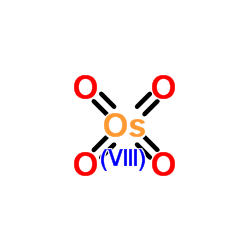Osmium tetroxide

Osmium tetroxide structure
|
Common Name | Osmium tetroxide | ||
|---|---|---|---|---|
| CAS Number | 20816-12-0 | Molecular Weight | 254.228 | |
| Density | 1.04 | Boiling Point | 130 °C | |
| Molecular Formula | O4Os | Melting Point | 40°C | |
| MSDS | Chinese USA | Flash Point | -40 °C | |
| Symbol |



GHS05, GHS06, GHS08 |
Signal Word | Danger | |
|
Alveolar-capillary adaptation to chronic hypoxia in the fatty lung.
Acta Physiol. (Oxf.) 213(4) , 933-46, (2015) Obese diabetic (ZDF fa/fa) rats with genetic leptin resistance suffer chronic lipotoxicity associated with age-related lung restriction and abnormal alveolar ultrastructure. We hypothesized that these abnormalities impair adaptation to ambient hypoxia.Male fa... |
|
|
The biocompatibility of degradable magnesium interference screws: an experimental study with sheep.
Biomed Res. Int. 2015 , 943603, (2015) Screws for ligament reconstruction are nowadays mostly made of poly-L-lactide (PLLA). However, magnesium-based biomaterials are gathering increased interest in this research field because of their good mechanical property and osteoanabolic influence on bone m... |
|
|
Melanoma cells homing to the brain: an in vitro model.
Biomed Res. Int. 2015 , 476069, (2015) We developed an in vitro contact through-feet blood brain barrier (BBB) model built using type IV collagen, rat astrocytes, and human umbilical vein endothelial cells (HUVECs) cocultured through Transwell porous polycarbonate membrane. The contact between ast... |
|
|
A laser-induced mouse model with long-term intraocular pressure elevation.
PLoS ONE 9(9) , e107446, (2014) To develop and characterize a mouse model with intraocular pressure (IOP) elevation after laser photocoagulation on the trabecular meshwork (TM), which may serve as a model to investigate the potential of stem cell-based therapies for glaucoma.IOP was measure... |
|
|
Brief reports: Lysosomal cross-correction by hematopoietic stem cell-derived macrophages via tunneling nanotubes.
Stem Cells 33(1) , 301-9, (2014) Despite controversies on the potential of hematopoietic stem cells (HSCs) to promote tissue repair, we previously showed that HSC transplantation could correct cystinosis, a multisystemic lysosomal storage disease, caused by a defective lysosomal membrane cys... |
|
|
Four different synthetic peptides of proteolipid protein induce a distinct antibody response in MP4-induced experimental autoimmune encephalomyelitis.
Clin. Immunol. 159 , 93-106, (2015) Here we studied the autoantibody specificity elicited by proteolipid protein (PLP) in MP4-induced experimental autoimmune encephalomyelitis, a mouse model of multiple sclerosis (MS). In C57BL/6 (B6) mice, antibodies were induced by immunization with one of th... |
|
|
Growth and functional harvesting of human mesenchymal stromal cells cultured on a microcarrier-based system.
Biotechnol. Prog. 30(4) , 889-95, (2014) Human mesenchymal stromal cells (hMSCs) cells are attractive for applications in tissue engineering and cell therapy. Because of the low availability of hMSCs in tissues and the high doses of hMSCs necessary for infusion, scalable and cost-effective technolog... |
|
|
Killing of Mycolic Acid-Containing Bacteria Aborted Induction of Antibiotic Production by Streptomyces in Combined-Culture.
PLoS ONE 10 , e0142372, (2015) Co-culture of Streptomyces with mycolic acid-containing bacteria (MACB), which we termed "combined-culture," alters the secondary metabolism pattern in Streptomyces and has been a useful method for the discovery of bioactive natural products. In the course of... |
|
|
Chitosan functionalisation of gold nanoparticles encourages particle uptake and induces cytotoxicity and pro-inflammatory conditions in phagocytic cells, as well as enhancing particle interactions with serum components.
J. Nanobiotechnology 13 , 84, (2015) Gold nanoparticles (AuNPs) are a popular choice for use in medical and biomedical research applications. With suitable functionalisation AuNPs can be applied in drug delivery systems, or can aid in disease diagnosis. One such functionalisation is with chitosa... |
|
|
Transplantation of Human Neural Progenitor Cells Expressing IGF-1 Enhances Retinal Ganglion Cell Survival.
PLoS ONE 10 , e0125695, (2015) We have previously characterized human neuronal progenitor cells (hNP) that can adopt a retinal ganglion cell (RGC)-like morphology within the RGC and nerve fiber layers of the retina. In an effort to determine whether hNPs could be used a candidate cells for... |